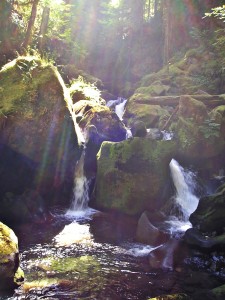 I was raised on creek fishing. I used bait, and then spinners and spoons, and then at the advanced age of about twelve or thirteen, flies. So, now that I’ve hit 60, creeks are for me a very old habit.
I was raised on creek fishing. I used bait, and then spinners and spoons, and then at the advanced age of about twelve or thirteen, flies. So, now that I’ve hit 60, creeks are for me a very old habit.
I return to creeks every year, but not really out of nostalgia (though there’s a touch of that each time)–I do so simply because I’ve felt again the urge to wade and cast in a beautiful miniature world, shut away for a few hours from the great wide world and even from other fly fishers (other than my fishing partner of the day). Creeks offer a privacy no river–and certainly no lake or saltwater bay–can match. When I’m looking upstream and see only clear, tumbling water split by boulders and lazing through pools, framed by green ferns and green forest, the line of the creek turning out of view only a modest cast away, I remember why I’ve returned. A hundred feet up and down the creek there may be other anglers, but it doesn’t matter–a hundred feet, a hundred miles, they’re out of sight and completely out of my mind. This is a sense of isolation I can’t find on the Henry’s Fork or the Deschutes–magnificent as both are–and sometimes it’s comforting.
Creeks are nearly always beautiful. Most of our Pacific Northwest creeks tumble and stall and tumble again through forest while a few glide gently through meadows. Back high in the mountains they may be washed clean along their broad edges by runoff, receding in summer to thread as trickles down the centers of their stony highways. Desert creeks are a whole other matter. I haven’t fished many in Washington and Oregon, but a few of those I have fished held some large trout amid the tumbleweeds and powdery dust, the richness of the arid country combined with cold water from springs or mountain headwaters.
But on the whole, our Northwest creeks, like most others I’ve fished across North America, produce small trout. Six- or seven-inchers are typical, and in many of our creeks a twelve-incher is a trophy. On the west side, most of these are hungry, fit, perfect coastal cutthroat trout with yellowy flanks and scarlet jaw-slashes and black spots everywhere. And to the best of my knowledge, they are always wild fish. They’ll smack down a dry fly with conviction and come to a nymph sometimes even better. They are rarely moody. On the east side they may be rainbows or cutthroats, and if they’re provided a generous supply of food–which over there they sometimes are–they can afford to pick and choose, making our job as fly fishers more challenging. That brings its own appeal.
I go to most of these creeks with a short, light rod and a single box of flies, just as I have for the better part of 50 years. To the rich creeks where just the right nymph or emerger-fly may be required, I bring it all–a vest-full of flies and tippets.
If my joints and my heart carry me through another 10 or 15 years of breaking through brush and scaling down into and up out of rugged creek canyons, I’ll be grateful, and I’ll keep going back.
by Skip Morris
Web-site: www.skip-morris-fly-tying.com

